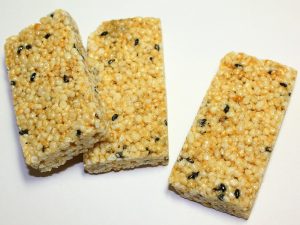
Okoshi (おこし) is a type of traditional Japanese sweet (wagashi). It’s also called okoshigome (おこし米).
While it’s often made with processed rice, it can be made with other grains too.
Syrup and sugar give the mix sweetness, plus they act as a glue to hold the shape of the okoshi.
History of okoshi
I saw more than once online that this is Japan’s oldest sweet, but I couldn’t find definite proof.
The historical records show that the basic version of this snack came from China to Japan in the Heian period (794 – 1185).
But it wasn’t called okoshi at the time.
There’s an entry about it on a dictionary of that era called Wamyoruijusho (和名類聚抄).
Only the nobility had access to this sweet.
From other written sources, it’s known that it was considered elegant to wipe the bits of okoshi that fell into one’s clothes after eating.
At the beginning of the Muromashi period (1336 – 1573), the word okoshigome starts to appear.
The population at large began to eat it during the Edo period (1603 – 1868).
It started to take the shape and ingredients of modern okoshi.
During the Russo-Japanese War, Emperor Meiji sent 350,000 boxes of okoshi to the soldiers.
The soldiers were very impressed with this imperial gift.
Many chose to bring it with them after the war in order to share it with their loved ones, and this led to an even higher demand for okoshi all throughout Japan.
Types of okoshi
Two of the most popular traditional types of okoshi are kaminari okoshi (雷おこし) and iwa okoshi (岩おこし).
Kaminari okoshi, which means “thunder okoshi”, is named after the Kaminarimon, a gate in the Sensoji temple in Tokyo.
It’s made with puffed rice, syrup, sugar and additional ingredients such as peanuts.
Iwa okoshi, meaning “rock okoshi”, comes from Osaka.
It’s main feature is that the rice is broken, so the firmness is different.
Iwa okoshi often contains ginger as well.
There are many regional types of okoshi in Japan, as well as modern versions which include different ingredients.
Here’s a video of a street vendor making okoshi:
